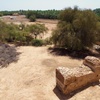Disclaimer
This entry contains information known to us from a variety of sources but may not include all the information currently available. Please be in touch if you notice any inadvertent mistakes in our presentation or have additional knowledge or sources to share. Thank you.
Archive
Cemetery at Sohar, Oman
Professor Aviva Klein-Franke "visited Oman twice to investigate the Jewish cemetery at Sohar. I took many photographs of the site and documented the names which are written on the bricks of the Memorial Wall. Under the rule of the Persians the port of Sohar was built, Merchants from Persia founded colonies along the eastern shore of the Arabian Gulf. Sohar became a famous port. Trade Agencies from overseas settled at Sohar and traded with goods from China and Japan, Persia and Iraq, India and Yemen, Ethiopia and Egypt. Sohar became what the port of Aden had been, a place for exchanging goods. In the mercantile society of Sohar there also lived Jews originating from Persia and Iraq. From the size of the Jewish cemetery at Sohar we can assume that in the past there was a big Jewish community at Sohar. The Jewish cemetery at Sohar was mentioned in a few works by scholars and travellers. Wellsted in 1835 found only 20 Jewish families living at Sohar, who had a synagogue and owned a few buildings. P. Costa mentioned Bayt Yahudi, which still stand as evidence of the past Jewish community of Sohar, but actually the important physical evidence is the Jewish cemetery of Sohar. In 1958 Wendell Phillips and Alexander Honeyman measured the cemetery and investigated a few tombs out of two hundred. Paolo Costa illustrated the subject with many historical and ethnographic details. In 1980 he counted 95 graves in the cemetery. From year to year the number of graves decreased. In my visit at Sohar in the year 2005 I could count only 12 full tombs and another 5 half-open tombs. All over the ground there are bones scattered. The tombs have an unusual ellipse form, built of bricks and mortar in the form of steps of 5-7 rows; the higher the row, the shorter the ellipse. In the front of the cemetery there is a massive memorial wall from Bricks. Many Hebrew names are engraved into the bricks on the four sides of the wall. Until today the names have not been documented. I copied most of them and took the measure of the wall. I went through the Hebrew sources dealing with Arabia and commerce in the Middle East in mediaeval times, I went through the 'Cairo Geniza' documents as well as Jewish and travellers´ sources and found some interesting related information about the Jews of Arabia as Traders."
Description
Jewish Community of Sohar: The early Jewish community of Sohar became famous through Ishaq bin Yahuda, a Sohari merchant mentioned by Buzurq ibn Shahriyar in his "Kitab 'Aja'ib al-Hind" ("Book of the Wonders of India," c. 950). He writes that the Jewish merchant seaman, Ishaq bin Yahuda, visited China from Sohar between the years 882 and 912 after a quarrel with a Jewish colleague. Ishaq left Sohar in poverty to seek his fortune in China and returned to Oman thirty years later with great wealth. After a disagreement with the local ruler he sailed for China again, but at the port of Sumatra his ship and its contents were seized and Ishaq was murdered. British Lieutenant J.R. Wellsted mentions in his memoirs, "Travels in Arabia, vol. 1," about the Jews of Muskat. Wellsted states that Jews are not discriminated against in Oman as they are in other Arab countries such as Yemen and Syria, and do not have to wear any markings to identify themselves as Jews. He writes also that Jews are not restricted to living in one concentrated area, nor are they required to walk in the road if a Muslim is walking on the same street, as they were in Yemen. The Jews in Muskat were employed in many professions, but many were involved in the fabrication of silver ornaments, banking, and liquor sale. Despite this, the Jewish community disappeared by 1900.
Suggested Further Reading:
- "Sohar, Culture and Society in an Omani Town" by Fredrik Barth
Sources
http://www.arabianseminar.org.uk/abstracts2006.html
Stillman, Norman A. The Jews of Arab Lands. The Jewish Publication Society of America; Philadelphia, 1979




